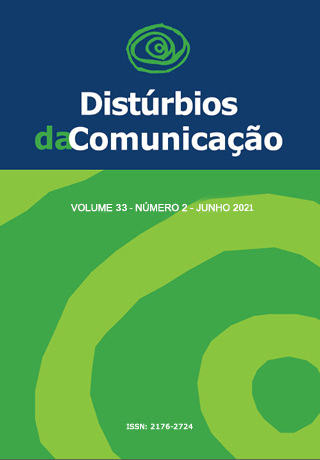Análise da mastigação e deglutição na paralisia cerebral com deficiência visual: estudo de caso
DOI:
https://doi.org/10.23925/2176-2724.2021v33i2p204-212Palavras-chave:
Paralisia Cerebral, Deficiência Visual, Mastigação, Transtornos da deglutiçãoResumo
Introdução: A Paralisia Cerebral pode acarretar alterações em qualquer uma das fases da deglutição, causando uma disfagia neurogênica. No entanto, desordem neurológica e deficiência visual associada é um tema pouco estudado. A criança com a ausência do canal visual, geralmente tem pouca noção na estrutura do espaço e até mesmo em relação à sua estrutura corporal e organizacional. É sabido que a Paralisia Cerebral discorre atrasos no padrão mastigatório e da deglutição, mas questiona-se se a deficiência visual pode interferir ou não neste desempenho. Objetivo: O propósito deste estudo foi analisar as funções de mastigação e o tempo de deglutição em criança com paralisia cerebral e deficiência visual associada. Método: Esta pesquisa é de natureza exploratória e descritiva, desenvolvida por meio de um estudo de caso clínico de uma criança com paralisia cerebral e deficiência visual associada. Três consistências de alimento foram examinadas: líquido (suco), pastosa (iogurte) e sólido (pão), sendo cronometrado o tempo gasto para deglutir cada uma delas, durante o horário normal de alimentação. Resultados: os resultados mostraram que a criança com Paralisia Cerebral e Deficiência Visual apresenta dificuldades na função de mastigação e leva mais tempo para deglutir nas consistências sólida e líquida. Conclusão: A deficiência visual associada à paralisia cerebral pode acentuar na dificuldade das funções de mastigação e deglutição.
Downloads
Referências
Silvério C.C, Henrique C.S. Indicadores da evolução do paciente com paralisia cerebral e disfagia orofaríngea após intervenção terapêutica. Revista Sociedade Brasileira de Fonoaudiolologia 2009; 14(3): 381-6.
Rotta, N.T. Paralisia cerebral, novas perspectivas terapêuticas. Jornal de Pediatria - Vol. 78, Supl.1 Rio Grande do Sul: 2002.
Bobath K. Uma base neurológica para o tratamento da paralisia cerebral. 2 ed. Traduzido por Ana Fátima Rodrigues Alves. São Paulo: Manole: 1990.
Geralis E. Crianças com paralisia cerebral:guia para pais e educadores. 2 ed. Porto Alegre: Artmed, 2007.
Hirata GC, Santos RS. Rehabilitation of oropharyngeal dysphagia in children with cerebral palsy: A systematic review of the speech therapy approach. Int. Arch. Otorhinolaryngol. 2012; 16(3): 396-9.
Furkim AM, Behlau MS, Weckx LLM. The use of cervical auscultation in tracheal aspiration in children with cerebral palsy. Rev. CEFAC. 2009; 11(4): 624-9.
Moura WF, Oliveira JR. Estudo descritivo e comparativo de parâmetros de Interação entre mãe e criança cega. Revista Distúrbios da Comunicação. São Paulo, abril 2011; 23 (1) 7-14.
Carvalho, Erenice Natália S. A educação especial: concepção de deficiência. Brasília, Secretaria de Educação Especial, Ministério da Educação, 1996.
Massini, Elcie F. Salzano. “Conversas sobre deficiência visual”. Revista Con-tato. São Paulo, Laramara, no 3, p. 24, 1993.
Vianna CIO, Suzuki HS. Cerebral palsy: analysis of swallowing patterns before and after speech therapy intervention. Rev. CEFAC. 2011; 13(5): 790-800.
Andrade, T. D. (1997). A família e a estruturação ocupacional do indivíduo. Em R. Levenfus (Org.), Psicodinâmica da escolha profissional (pp. 123-134). Porto Alegre, RS: Artes Médicas.
Vivone PG, Tavares MM, Bartolomeu RS, Nemr K, Chiappetta ALM. Análise da consistência alimentar e tempo de deglutição em crianças com Paralisia Cerebral Tetraplégica Espástica. Revista CEFAC, São Paulo, v.9, n.4, 504-511, out-dez, 2007.
Amiralian, Maria Lúcia Toledo Moraes. Compreendendo o cego: uma visão psicanalista da cegueira por meio de desenhos-estorias. São Paulo: Casa do Psicólogo, 1997. 321p.
Ribeiro OM, Rahal RO, Kokanj AS, Bittar DP. O uso da bandagem elástica Kinesio no controle da sialorréia em crianças com paralisia cerebral. Revista Acta Fisiatrica 16(4). São Paulo, 2009.
Lucchi C, Florio CP, Silverio CC, Reis TM. Incidência de disfagia orofaríngea em pacientes com paralisia cerebral do tipo tetraparéticos espásticos institucionalizados. Rev Soc Bras Fonoaudiologia 2009 ;14(2): 172-6.
Rocha EMS. Disfagia: avaliação e terapia. In: MARCHESAN, I.Q. - Fundamentos em fonoaudiologia: aspectos clínicos da motricidade oral. Rio de Janeiro, Guanabara Koogan, 1998. p.91-8.
Aurélio SR, Genário KF, Filho EM. Análise comparativa dos padrões da deglutição de crianças com paralisia cerebral e crianças normais. Revista brasileira de otorrinolaringologia. 68 (2) parte 1. Paraná: 2002.
Silva RG. A eficácia da reabilitação em disfagia orofaríngea. Pró-Fono. 2007.Jan-Abr; 19(1): 123-30.
Araújo LA, Silva LR, Mendes FAA. Digestive tract neural control and gastrointestinal disorders in cerebral palsy. J. Pediatr. 2012; 88(6): 455-64.
Vianna CIO, Suzuki HS. Cerebral palsy: analysis of swallowing patterns before and after speech therapy intervention. Rev. CEFAC. 2011; 13(5): 790-800.
Winnicott, D.W. A família e o desenvolvimento individual. Trad. Jefferson Luiz Camargo. Cap1 – O primeiro ano de vida. P 3-20. Editora São Paulo, 2005.
Euno SR, Cunha AC. Desenvolvimento da criança com deficiência visual (DV) e interação mãe-criança: algumas considerações. In: Revista psicologia, saúde e doenças: sociedade portuguesa de psicologia da saúde. Lisboa, Portugal, 2003 vol. 4, nº 001, p.33-46.
Downloads
Publicado
Edição
Seção
Licença
Copyright (c) 2021 Wanessa Moura Costa, Gerlane Karla Bezerra Oliveira Nascimento

Este trabalho está licenciado sob uma licença Creative Commons Attribution 4.0 International License.









